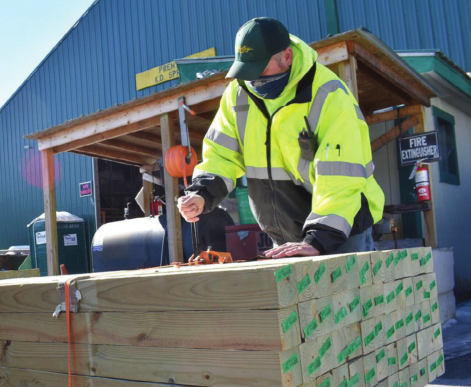When 2019 was getting ready to click over into 2020, there was already a problem brewing for local contractors, as the cost of basic building materials was increasing significantly.
It’s only gotten worse since then. Much worse. “It’s a crisis, and it’s going to be for a while,” said Brenda Richards, executive officer of the Lakes Region Builders and Remodelers Association.
The problem of price increases dates back to 2017, when the Trump administration enacted a tariff on softwoods coming from Canada, which supplies much of the U.S. lumber needs. But the pandemic made those price increases look quaint.
After the pandemic, she said, prices “started creeping up and then it exploded because of Covid.”
At Middleton Building Supply in Meredith, general manager Michael Mussen said that difficulty shipping over distances, especially across national borders, put a pinch on the availability of such materials as lumber and plywood. So, too, did temporary shutdowns of manufacturing facilities due to Covid outbreaks.

Tom
Learned, lumber yard foreman at Middleton Building Supply in Meredith,
straps a load of lumber together to move with a forklift. (Adam Drapcho/The Laconia Daily Sun)
Then there’s the demand side. Since the shutdown was put in place last year, people stuck at home decided it was time to build that new deck or addition or people who lived in congested areas pulled the trigger on a dream home in the country.
“Demand is way up, supply is down,” said Mussen. The result, he said, “is basic macroeconomics.”
At Middleton, Mussen said the cost of items such as a sheet of plywood or an eight-foot-long 2x4 — each of which are used by the truckload to build a new home — have gone up by 10% to 20% over the past six months, and are double what they were a year ago.
Yet, said Mussen, it hasn’t affected his business, which has continued to be brisk.
“The demand is so high,” he
said. His customers face the price increases with an attitude he
described as, “We need it, we need to get it done, we’ll pay.”
Other materials affected
But
how long will that approach last? In a letter to President Biden, dated
Jan. 29, 2021, John Fowke, CEO of the National Association of Home
Builders, warned that the construction sector, one of the few bright
spots of the economy during the pandemic, could be hamstrung by material
costs.
The NHAHB estimates that recent increases in material costs add an average of $24,000 to new home construction.
“Housing
can do its part to create jobs and lead the economy forward, but in
order to do so, we need your help to address skyrocketing lumber prices
and chronic short ages.
We
respectfully request that you reach out to domestic lumber producers to
urge them to increase lumber production to address these shortages and
to ask the Department of Commerce to investigate why production remains
at such low levels during this period of high demand.”
Fowke also urged the Biden administration to come to an agreement with
Canada about increasing lumber shipments over the border.
Contractors
are starting to see the price increases spread to non-lumber materials,
said Ryan Laramie, project coordinator for Gilford-based contractors
Wood & Clay.
“The
most recent problems we’ve noticed is wiring and copper,” Laramie said,
as well as the plastic boxes that electricians use to house outlets and
light switches. There are scores of those in a large home, and they’ve
recently jumped in price by a third — and that’s if they’re available.
Oddly, the price fluctuations haven’t scared away customers, Laramie said.
“We
haven’t seen any cutbacks. If anything, we’ve probably gotten, on
average, two requests a day to build somebody’s house or project of some
sort. We’ve been able to pick and choose what we work on. I haven’t
seen a slowdown. If anything, the houses are getting bigger and more
lavish,” Laramie said.
And that trend is something that worries Richards of the Lakes
Region builders’ association. New entry-level homes have become unicorns
in the region — perhaps the spiking cost of materials could close the
damper on an overheated market, allowing things to return to balance,
she said.
“It’s a
little scary, but I’m an optimist. I think it will modify, and homes
will do what they always do. This might be the thing that slows it down
and brings it to a reality check,” Richards said. “It kind of has a
cycle. I think right now it’s really hard to find a home that you can
afford. Maybe it’s OK that it moderates at some point.”
This article is being shared by partners in the Granite State News Collaborative. For more information, visit collaborativenh.org.